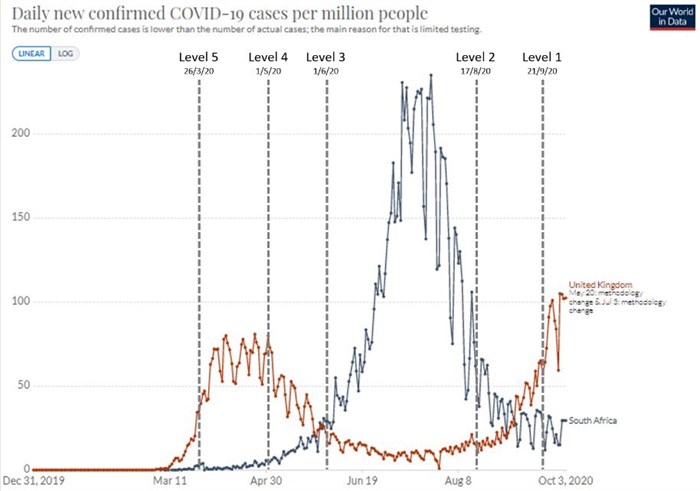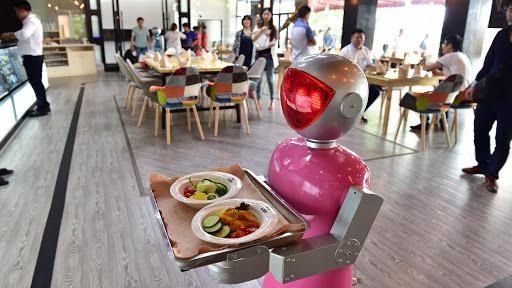
Subscribe & Follow
#AfricaMonth
Jobs
- Commercial Head (Beverages) Johannesburg
- Distribution Partner Manager - Liquor Johannesburg
- Floor Manager Cape Town
- Perishable Supervisor Cape Town
- Customer Service (Work from Home) UK market Johannesburg
In the news
Restaurants and fast food outlets need a mindset change post Covid-19

Four months later, we are in Level 1 lockdown and the regulations have been significantly relaxed. Restaurants have to remain at 50% of their capacity and customers still have to social distance and wear masks. Restaurants are now able to close at midnight and are able to sell alcohol. As the restrictions are reduced, customers are becoming more willing to go out to restaurants and fast food outlets.
This has been my personal experience and I have found that restaurant management have not been able to fully implement the required controls and others were simply out of control. This is largely a consequence of the lack of management skills and poorly trained staff. Patrons were also walking around without any thought of social distancing or the wearing of masks. There just seemed to be no appreciation of regulations and the potential impact of the pandemic on the South African population. I got to the point where I wondered whether they knew something that I did not. As a medical practitioner from Westville put it, they think they are ‘silver bullets’ - they are invulnerable to Covid-19 and no risk to their ‘elderly relatives’.
Mixed Covid-19 messages hamper restaurant and fast food industry opening more fully
All of this must mean that the risk associated with Covid-19 is declining and as a consequence, social distancing regulations can be further relaxed. Research in the United States done by sense360 has shown that most people do not believe that the relaxing of lockdown regulations are based on medical or scientific knowledge but purely for economic reasons. In the South African context, Covid-19 reached its peak around the 24 July 2020 and has continued to decline as is reflected in figure one below. Nevertheless, we are still averaging around 1,000 new Covid cases and over 50 deaths per day. Michael O’ Donovan, who has done extensive research on Covid-19 in South Africa, believes that by around the middle of November we should start to see no new confirmed cases. Time will tell whether this prediction is correct but there is still a long way to go before we can officially say the pandemic is over.

South Africa’s situation is in contrast to many other countries in the world which are experiencing a second ‘wave’ or increases in the number of daily confirmed cases. The consequences of these increases have seen the United Kingdom government going to stricter lockdown measures, resulting in the closure of bars and restaurants again. Ivor Cummins provides some convincing evidence from the analysis of data and academic research that the pandemic ended in May/June in Europe and that it is following the same progression as other influenza and coronaviruses in the past. He also cites research that indicates that masks and lock down have had little effect on the progression of Covid-19. This is largely substantiated by the presentation done by Michael Donovan on the trends of Covid-19 in South Africa since its beginning.
The stages at which the different levels of lockdown were implemented in South Africa are plotted in figure one and one can see that there was no significant variation in the progression of the Covid-19 daily confirmed cases per million people. This largely substantiates what is presented by Ivor Cummings. So, what are we to make of the second ’wave’ being shown in figure one in the United Kingdom? According to research presented by Cummings, a second ‘wave’ can be explained by the way that the virus progresses in different climatic regions (e.g. temperate and tropical regions of the United States) and that found in many European countries, which is a consequence of the testing finding dead viral fragments of asymptomatic people (false positives).
Better understanding of Covid-19 critically needed
The United Kingdom opened their pubs in early July 2020 with no regulations for wearing masks and limited distancing and since then, there have been millions of interactions between customers. For a month after the opening of the pubs, the daily confirmed Covid-19 cases continued to decline but have now risen way above the original peak of the first ‘wave’ in April 2020. Figure two shows a comparison of the daily confirmed Covid-19 cases and deaths. What is immediately apparent is the significant decline in the number of deaths during the second ‘wave’. At the peak of the first ’wave’ of the pandemic, the United Kingdom had 1,224 Covid-19 deaths per day compared to only 50 registered on the 4 October 2020. With the United Kingdom heading towards their flu season there will be an increase in deaths like many other European countries from influenza and Covid-19. With South Africa heading towards its flu season in mid-2021, Michael O’ Donovan believes that we will see a significant increase in flu related deaths in our country.

A striking aspect of this pandemic is the lack of knowledge of the SARS Covid-2 virus. We are not sure of where it came from (i.e. pangolin or laboratory), how it actually infects our bodies (e.g. through aerosols or not) or what are the medical protocols that should be followed when a person has a severe case of this disease (i.e. is it a blood or lung disease). A key reason for this has been the poor communication by international institutions, such as the World Health Organisation (WHO) and national governments, such as our own. Most people in South Africa would want the reason for the reduction of lockdown restrictions to be a clear understanding of the declining trends associated with Covid-19, that the original reasons for the lockdown of improving the capacity of health facilities to deal with patients had been achieved and knowing that the virus is not going to continue having an impact on our society. Research in the United States is showing that people believe that the main reason is to minimise the impact on the economy and job losses rather than in solid scientific knowledge of the progression of this pandemic.
I remain not fully convinced about the arguments for and against social distancing and the wearing of masks. We have heard over the last seven months governments say that they are ‘following the science’ and yet so many scientists have got it wrong. This necessitates continued caution until it is clear that the risk from the pandemic has declined to a level that we can remove all the regulations for social distancing. Ultimately, to prevent continued mixed messages, the world needs to establish an international forum of recognised experts from the different regions to provide consensus on the progression of the pandemic, the social distancing regulations that must be maintained and the medical protocols that should be followed in the treating of severely ill patients until a vaccine is available.
Mindset change - a key aspect of the future restaurant and fast food industry
The impact of Covid-19 on the restaurant and fast food industry will continue for months to come but with hindsight, we should be able to plan for the lifting of the lockdown at an appropriate time. Hopefully, that time would be the Christmas season, which is a critical time of the year for restaurants and fast food outlets alike, as the turnover generated during these months is often what sustains them for the remaining part of the year. As has been experienced in the United States, it can be anticipated that restaurants will not get back to full capacity with them having to continue social distancing and customers and staff wearing masks. The extended lockdown has also brought about changes in eating habits with people cooking at home and eating healthier foods.
The research done by sense360 has shown that consumer behavior has changed towards better value propositions offered by restaurants and fast food outlets as a consequence of the economic situation. Other aspects that have increased in importance among customers is their need to feel safe, familiarity with restaurants and fast food outlets and the ease of ordering to enable them to limit their exposure to catching the virus. If the United States is anything to go by, key changes in the industry will be an increase in company owned delivery services, discounted offerings and the provision of curbside and carry out facilities.

There is a strong likelihood that people will be slow to return to work and companies and their employees agreeing to them working from home. This will have a significant impact on the restaurant and fast food industry in the coming months as offices in central business districts (CBD), large commercial areas and office parks are not filled to capacity. This, again, talks to the necessity to look more effectively at existing restaurant and fast food outlet networks through the use of appropriate geospatial methods. What is being seen in the United States, is that restaurants and fast food outlets are moving closer to residential areas where more people are working from home and companies opening up many smaller sites.
Opportunity for the larger brands to fill gaps where independent and smaller companies had restaurants or fast food outlets that closed, will continue to open up. However, the size, type and distribution of restaurants and fast food outlets will still have to be looked at very carefully to ensure that they have an optimised network. These smaller sites will focus less on dining-in and more on the use of high end technologies to enable mobile ordering to bolster the experience and convenience to customers. More drive-through, curbside and pick-up facilities at restaurants and fast food outlets will open up in the South African market, as is the case in the United States.
To be able to develop an optimised restaurant and fast food outlet network requires access to granular data on the target market as well as their changing traveling habits in the ‘new normal’. To do this requires access to data on the location of customers using restaurants and fast food outlets. This means collecting a physical address or the geographic coordinates of a customer so that the location where they work or live can be geolocated. In the restaurant and fast food industry this is best accomplished through the use of loyalty cards, reward schemes and mobile apps used to order food. Through this approach a comprehensive customer database can be built that will allow the trade areas of individual restaurants and fast food outlets to be defined so that the average travel time of customers going to restaurants of different types and sizes can be determined.
In conclusion, I still believe strongly that the restaurant and fast food industry should continue to focus on how they safeguard their customers and employees from Covid-19. For this to happen requires a strengthening of the leadership role of management in restaurants and fast food outlets and building the capacity of staff members. We also need a clearer picture of how the pandemic is progressing in South Africa and globally, through the provision of clear messages by the government and international organisations. These factors as well as their impact, require a mindset change to ensure the sustainability of the restaurant and fast food industry into the future because it plays such a critical role in the economy of the country as well as in the provision of employment.

About Craig Schwabe
Craig Schwabe, a distinguished geoinformation professional, has significantly shaped the industry in both government and the private sector in South Africa and across Africa. His expertise spans the conceptualization and management of qualitative and quantitative surveys, including national perception surveys and citizen report card surveys.Related
Changing systems to reduce obesity in SA 4 Mar 2025 UP’s Prof De Wet Swanepoel wins International Award for Hearing for improving access to hearing healthcare 28 Feb 2025 Advancing equity - breastfeeding support for all 30 Jul 2024 Africa unites to bring nuclear nutrition expertise to the continent 2 Apr 2024 Medical aid cover for physical rehabilitation and physical therapy in South Africa, by Medshield 28 Mar 2024

















